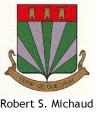 |
Article reprinted with permission from:

—Home—Subscriptions—Staff—Back Issues—
FJ1100-1200 Used Bike Buyer's Guide
by Jay Koblenz
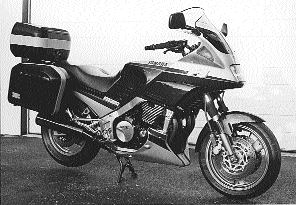 There may never be another motorcycle quite like Yamaha's FJ1200, and our survey indicates there are many happy owners who will miss it. Fortunately, there are many FJs still around from the ten years Yamaha sold it in the U.S. It has proven to be a durable, long-lasting mount that serves its rider well for many miles with proper care. There may never be another motorcycle quite like Yamaha's FJ1200, and our survey indicates there are many happy owners who will miss it. Fortunately, there are many FJs still around from the ten years Yamaha sold it in the U.S. It has proven to be a durable, long-lasting mount that serves its rider well for many miles with proper care.
Jack Pomaro of Westmont, Illinois sent this picture of his 1992 FJ1200 in with his survey. Fitted out for touring, this bike sports Krauser hard luggage, Heli-Bar handlebars and Progressive Suspension fork springs. Jack's message to Yamaha: "Don't bring the FJ back! I want to be the only kid on the block with the best in long-haul comfort, unlimited power, top-notch sportiness and rock-solid reliability."
When it arrived on the scene in 1984 as the FJ1100, it was already among the last of a breed: The air-cooled, large displacement inline-four. It was countered that year by Honda's V65 Sabre. The Honda offered a smoother engine, water-cooling, shaft drive and, perhaps most importantly, a price tag nearly 10% lower.
Things didn't get any better for Yamaha a year later when Honda lowered the Sabre's list price even further, and Yamaha just managed to maintain the line on the FJ. But in 1986, Yamaha punched out the engine to 1200cc and had the market to itself when Honda dropped the big Sabre. The only competition then was Kawasaki's more touring-oriented Concours and Suzuki's bare-bike GS1100. With air cooling and chain final drive, the big Yamaha would soldier on as the most simple and basic design for a sport-touring bike that still lent itself well to multiple tasks.
Except for a hiatus in 1988, when the entire motorcycle market was in its most severe doldrums, Yamaha kept the FJ1200 around largely unchanged through 1994 (when it tested the market with the super-high tech, but short-lived GTS1000). Judging by the response from MCN's ownership survey, there is still some demand for a bike like the FJ1200, but the era of such a low-tech sport-tourer may be permanently over. The closest thing now coming to market will be Suzuki's 1200 Bandit, a motorcycle already finding limited success in the European market.
Likes
What do owners like best about their FJs? That big powerplant is the number-one reason given for ownership. Nearly 72% of owners love the overpowering mid-range torque of that monster engine. This is the kind of real-world power that allows a rider to carry ample luggage and a passenger, then set out for many miles of effortless cruising. With gobs of reserve power, the engine never feels stressed out under load.
Next most popular on the list of positive features is the styling. Most people buy motorcycles because they like the way they look, and the FJ lasted a decade nearly unchanged. It has much of the grace of a pure sportbike with a low, forward leaning appearance. The pipes have an upsweep to continue the sporty theme, yet are low enough for sizable throw-over saddlebags.
Graphics never got too wild: Yamaha stayed with simple, clean lines to accent an inherent aggressiveness. There's virtually no chrome on a bike that dates to when shiny glitter was the private domain of cruisers and juggernaut luxo-tourers.
Judging by the MCN survey, Yamaha has a very happy ownership contingent among its FJ buyers. The overwhelmingly popular rating by owners was "excellent," that response checked off by over 70% of respondents. Only a single respondent checked "good," another unhappy owner checked "poor" and the remaining 29 percent checked "very good." This is obviously a bike that satisfies customers.
Accessories
Of course, that doesn't mean the FJ is perfect. As with most motorcycles, the FJ requires a few accessories to make it right for a lot of people. The first choice for modifications is a new seat. Although some owners were happy with the wide, flat stock unit, Corbin does a very good business with this model. One reason for the popularity of a more comfortable seat is that the FJ is frequently used as a long-distance machine. Luggage was the next most popular accessory, most frequently a tankbag.
The most common mechanical change is a new exhaust. Although FJs ridden in foul weather can suffer from some degradation of the inside of the mufflers, it's more likely the search for a sportier exhaust note is the top reason for the change.
A large number of owners changed out the stock fork springs. This is of little surprise, as the FJ is known for having an overly soft front suspension. A firmer spring and slightly heavier weight fork oil is a common fix to improve handling.
Still keeping with the touring theme, large numbers of owners added taller windshields and throttle locks. The stock shield was a bit short in early years and most of the changes were made to those prior to 1990. Another sizable group also went for taller handlebars for more comfortable cruising. For minor mishaps, Yamaha offers case guards that can protect some of the more expensive pieces.
When it comes to replacement rubber, Metzeler is by far the most popular choice, more than twice as common as the next most frequent pick, Dunlop. On the front, the ME33 is the most common choice, although more than a few moved to radials. The rear tires varied quite a bit from the ME55 and ME99 to an assortment of others. Michelins and Avons were fairly popular, also, with only a smattering of owners opting for Bridgestones.
Dislikes
When it comes to durability, the fact that the FJ lasted so long with so few changes is a strong indicator of a motorcycle without many problems. Of the items owners listed for what they liked least about the FJ, the two most popular answers were "nothing" and "weight." Nearly as many (still, fewer than 3%) of respondents didn't like the vibration. A couple owners had problems with the rear wheel bearings, something that needs watching on FJs that haven't been properly greased or have had the rear wheels sprayed with a power hose. Others didn't like the older design suspension and the maintenance of chain drive in a class where competitors went to shaft.
Surprisingly few owners criticized the 16" front tire on early models. Also, early models had anti-dive mechanisms that didn't work very well. This was simply left off the later models.
Although commuting and day trips headed the list as the most popular primary uses of the FJ, weekend excursions and long distance travel were also popular. But just because commuting may be the most common use doesn't mean that long-distance travel is rare. And although it's a large, heavy bike with limited cornering ability, a couple of owners even take their FJs racing.
A relatively small percentage of owners bought the ABS model, although the single year (1992) when it was an option, more than 40 percent of respondents went for it. Those who have the ABS model tend to like that feature, although most would rather save the $1200 Yamaha charged for it.
Desires
What do FJ owners want? The most popular request was a switch to shaft drive. Many would like more accessories, including hard saddlebags and a better fairing. A few want the bike to be water-cooled and lighter weight. Other requests were largely the kind of items Yamaha would have had to change to keep the bike current, such as a more refined suspension and improved ground clearance.
Although a huge percentage of owners would like to see the FJ1200 return to the Yamaha line-up, the company has no plans to get back into this marketplace. So an improved FJ does not seem to be in the cards. However, there are plenty of older ones around at bargain prices, and if this seems like the bike that suits you, it might be good to grab one soon.
What's It Worth?
Prices are a national average for an undamaged, well-maintained, moderate-mileage model, and may vary in your area due to regional supply and demand. A complete listing of prices for other motorcycles, PWC, ATVs and snowmobiles is available from the AMA's Official Motorcycle Value Guide or for $12.95 from CPI at (800) 972-5312.
|
Year
|
MSRP
|
Wholesale
|
Retail
|
Trade-In
|
|
1984 FJ1100
|
$4,999
|
$1,750
|
$2,400
|
$1,450
|
|
1985 FJ1100
|
$4,999
|
$1,850
|
$2,500
|
$1,550
|
|
1986 FJ1200
|
$5,199
|
$2,075
|
$2,725
|
$1,780
|
|
1987 FJ1200
|
$5,649
|
$2,275
|
$2,950
|
$1,980
|
|
1988 (not offered)
|
N/A
|
N/A
|
N/A
|
N/A
|
|
1989 FJ1200
|
$6,399
|
$2,775
|
$3,600
|
$2,480
|
|
1990 FJ1200
|
$6,699
|
$3,025
|
$3,900
|
$2,730
|
|
1991 FJ1200
|
$7,699
|
$3,450
|
$4,475
|
$3,150
|
|
1992 FJ1200
|
$7,399
|
$3,950
|
$5,050
|
$3,650
|
|
1992 FJ1200A (ABS)
|
$8,599
|
$4,525
|
$5,775
|
$4,230
|
|
1993 FJ1200A (ABS)
|
$8,999
|
$4,925
|
$6,300
|
$4,630
|
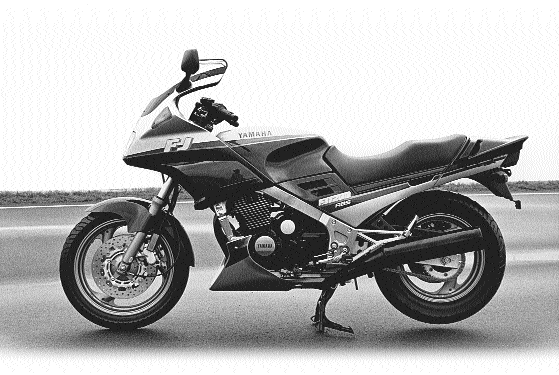
Brake Lines: With this much weight, even later model brakes aren't quite strong enough. A switch to braided steel brake lines removes some of the mushy feel. Fairing Plastics are expensive, as is usually the case. You can't swap salvaged parts between pre- and post-1988 models. Front Forks: Mushy stock springs are a common replacement item. If you don't go too stiff, 10-weight oil should make the set-up right. Engine: Strong mid-range torque is king and durability is the ace. Dont worry about a minor ticking noise on the left side, but beware of a starter chain that causes a growl that won't go away when the engine warms. It means ultra high mileage. Battery: If youve got an ABS model, there's an expensive dry cell battery. Other models can replace a battery for one-third the price. Seat: The seat is long and wide with plenty of room for two. Still, a lot of owners go for more form-fitting replacements. ABS: ABS began as an option in 1992 and became standard in 1993. There is no off switch. The system is very sophisticated and effective, however. Front Brakes: Later models (post-1988) received four-piston calipers for improved stopping ability. Otherwise, you get twin pistons.Wheel Bearings: Early models could seize if cleaned with a high-pressure hose. You can find waterproof units, but keep them properly greased anyway.Exhaust: Twin exhausts can touch down in hard cornering. The note is also muted. Aftermarket units improve clearance and make the sound more aggressive if you don't mind the noise.
Buying a Used FJ
For those on the hunt, fortunately, there is no really bad year for the FJ1100 or FJ1200. But as is usually the case, the newer and more expensive models are going to be the best versions.
Because that huge powerplant has such good mid-range torque, there is little temptation for owners to get rev happy. This bodes well for longevity, a trait for which the FJ is well-known. High-mileage bikes are not a problem as long as they have been properly maintained.
There are very few known problem areas for this bike. The most common repair is a rounded-off second gear cog. This comes from lazy shifting or always maximizing acceleration through the gears. Because repairing the gear requires splitting the cases, this can get a bit expensive. A usually related problem is a burned-up clutch. The clutch repair is quite a bit easier and cheaper to fix, however.
Look for a properly maintained chain in good condition. This is an expensive chain, and with the power of this engine, you won't want to replace it with a cheap unit. A freshly installed, high-quality chain is a good item to have.
Rear wheel bearings can be burned out if improperly lubricated. This was most severe in the FJ1100s, and was largely cured in later models. If the model you're looking at is a particularly older or high mileage one, and still has the stock fork springs, that's something you should consider as an item you'll need to change. This is a relatively inexpensive change, however.
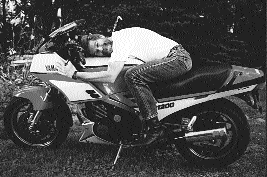 Joseph Hanner of Peekskill, NY shows his affection for his 1986 FJ1200 with Cobra F1 exhaust. Says Joe: How could Yamaha possibly discontinue such a great bike? Mileage: 29,860 Joseph Hanner of Peekskill, NY shows his affection for his 1986 FJ1200 with Cobra F1 exhaust. Says Joe: How could Yamaha possibly discontinue such a great bike? Mileage: 29,860
Few Model Year Changes
All the while the FJ was on sale in the U.S., there were few model year changes except for paint and graphics. It was the FJ1100 for 1984 and 1985. For 1986, the engine was enlarged to 1200, gaining some extra punch. The early years had anti-dive braking, but its effectiveness was lost by the time the bike had a few hundred miles on the clock.
Although it was sold in other countries, the FJ1200 was discontinued for a year in the U.S. during 1988. But there were plenty of leftovers from 1987 and earlier, so the FJ1200 was still being sold. Meanwhile, the bike received a number of changes that year that were made available when it returned to the U.S. in 1989. Two of the changes affected performance. A larger front wheel (17" versus 16") made handling more stable, particularly at high speed. The other significant change was the switch to four-piston (versus twin-piston) front brake calipers. For this long, heavy bike, this was a significant change for the better. Those who often load up their bikes with luggage and a passenger might find the 1989 and later models worthwhile for no other reason than the improved braking.
There were also some changes to the bodywork. Except for a taller windshield height, the look is largely the same. However, all the mounting points for the body changed. So, if you're looking for used body parts for an FJ, you have to stick with either the pre-1988 or post-1988 models, depending upon which one you have.
In 1991, Yamaha modified the engine mounts, eliminating nearly all the vibration. A new rear shock improved handling a bit, but wasn't a big enough change to make a dramatic difference.
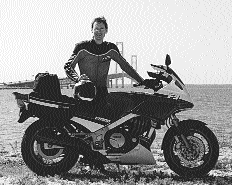
Edward Vannoller of Grand Rapids, MI poses with his 1991 FJ1200 with Eclipse luggage, Targa windshield and Heli-bars. Ed's message to Yamaha: Well done! Mileage: 23,235
Reasons to Buy
For a large inline-four, the FJ maintains a fairly low center of gravity. Handling is good on smooth roads, although it can get upset in bumpy corners. Firmer fork springs help, but serious scratchers will find ground clearance the limiting factor. It's possible to touch down the centerstand and exhaust. Even when modifying these parts, racers have been known to touch down the frame.
For a large, long sport-tourer, the FJ has a fairly low seat height of 31.1". It's no cruiser, but fairly short riders can get both feet down.
Perhaps best of all, this is a bargain for what you pay. With prices for non-ABS models rarely exceeding $5000, and early models getting below $2000, you can drum up a lot of comfortable and fast miles for little money.
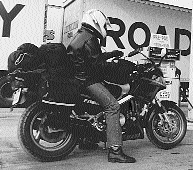
Jack Savage, Publishing Director for Motorbooks International, sent this snapshot of himself and his 1989 FJ1200 competing in the 1993 Iron Butt Rally, where they finished 9th overall. Says Jack: 11,000 hard, hot, cold, wet, long and occasionally fast miles later, the bike was ready and willing for more. Mileage: 41,362
Reasons to Avoid
If you're looking for a serious sportbike, this isn't your model. It doesn't love high rpm and it's too bulky for quick transitions in the corners. Then again, if you're looking for a super tourer, this won't match up to the smoothness of a Gold Wing or an ST1100.
But if this is your type of bike, just watch out for the usual array of problems. Beware of leaks in the fork seals and other places. Look over the wear on the chain and listen for unusual noises. If the bike runs right, odds are it is right.
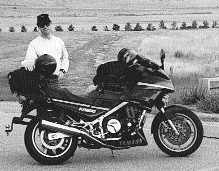
Mark Wallace of Castle Rock, CO has done some serious tinkering with his 1989 FJ1200, including (but not limited to) adding: Technomagnesio wheels, full-floating discs, EBC brake pads, Works Performance springs, Supertrapp exhaust, Corbin seat, Yamaha engine guards, K&N air filters, Sprocket Specialists 38-tooth sprocket and Heli-bars. Mileage: 26,000
Maintenance
Valve adjustments are by bucket and shim. These often needed changing during initial break-in, but tend to wear little after several thousand miles. Checking them is a bit of work, but access to the engine is quite good. There is a special service tool needed to depress the bucket to get the shim out if you do it yourself. The Yamaha lateral frame design and lack of liquid cooling means that getting to the powerplant is relatively simple.
Chains can last around 20,000 miles if you're a nut about lubrication. It's an expensive proposition to change the endless 0-ring chain: You'll have to drop the swingarm. Tires wear rather quickly, often less than 5000 miles at either end.
Best Bargains
To get the best deal, try to find an FJ with all the modifications you'd want to make anyway. If you're into the long haul, find one with a taller windshield, raised handlebars and the type of luggage you like. If you're in it for the performance, good features to have include braided steel brake lines and an aftermarket exhaust.
These are bikes that can suffer a fair amount of abuse without complaint. If you're looking at one that hasn't been treated kindly, it still might be worthwhile if the price reflects its demeanor. If all it lacks is a bit of spit and polish, you've found yourself a deal.
Getting Information
If you're a serious FJ enthusiast or just curious, there are both print and online newsletters. Deni Boyer used to publish a newsletter and plans to revive it. Write to Fastlane Jammin' at P.O. Box 535, Fair Lawn, NJ 07410. Those with internet access can try contacting Lee Carkenord at as899@freenet.uchsc.edu
Site and contents Copyright ©1997 Motorcycle Consumer News. All rights reserved. Reprinting in whole or in part expressly forbidden except by written permission of the publisher or editor. Motorcycle Consumer News (ISN 1073-9408) is published monthly by Aviation News Corporation, a subsidiary of Fancy Publications, 3 Borroughs, Irvine, CA 92618. Corporate headquarters located at P.O. Box 57900, Los Angeles, CA 90057-0900; (213) 385-2222
Copyright ©1997, Aviation News Corporation.
|
